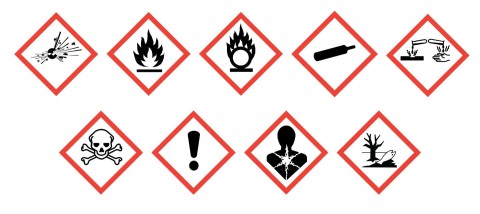Risk assessment: Hazardous substances in the workplace
Activities involving chemicals, from manufacturing and decanting to packaging and storage, are associated with a very special responsibility for companies. As an employer, you must ensure that the health of the employees in your company and the environment are reliably protected from the harmful effects of chemicals. The Hazardous Substances Ordinance (GefStoffV) and the Technical Rules for Hazardous Substances (TRGS) based on it form the legal basis for this.
According to the Occupational Health and Safety Act (ArbSchG), a risk assessment for activities involving hazardous substances is mandatory for all companies in which employees
- work in an environment where the air is contaminated with pollutants such as volatile solvents or dust;
- handle chemicals that are hazardous to health as part of their work;
- handle substances relevant to fire protection.
What are hazardous substances?
All chemical substances and mixtures of hazardous substances that can affect the health of employees in the workplace:
- Chemicals that are classified as hazardous - recognizable by the respective pictograms and/or hazard statements (H or EUH phrases),
- Other hazardous substances because they can be inhaled as dust, are cryogenic, very hot, coloring, sticky or have a strong odor.
Hazardous substance labeling: 9 pictograms and examples
The GHS hazard pictograms have been mandatory since the introduction of the CLP Regulation. In our blog, you can find out everything about the most important hazardous substance groups, their risks and practical examples of safe labeling.
Tasks of the employer
In principle, the employer must assess the effects and, in particular, the concentration of hazardous substances in the workplace by measurement or, for example, by calculation. If there is a lack of technical expertise in-house, external, preferably accredited, measuring bodies can also be commissioned to carry out the risk assessment. The German Accreditation Body ( DAkkS ) provides a list of all accredited measuring bodies on its website.
Risk assessment for hazardous substances
1. Define areas of responsibility and activities
Every workplace is different and exposed to different hazards. For this reason, the potential hazards posed by chemicals in the form of vapor, smoke or dust in production plants or laboratories, as well as during storage, must be individually determined and assessed. The basis for this is an inspection of the premises and an inspection of the working environment.
Such an inventory not only provides a detailed insight into operational structures and the areas in which hazardous substances are used, but also supports the creation of the prescribed hazardous substances register. Work areas and activities with comparable hazards can be considered together in the risk assessment. The criteria used to classify the areas of responsibility and activities depend on the individual circumstances of each company.
2. Identify hazards and assess risks
The following aspects, among others, play a role in assessing the extent to which employees are exposed to hazardous substances at their workplaces:
- Type of activity
- Work area (laboratory, production hall, etc.)
- Type of hazardous substances
- How often and for how long are employees exposed to hazardous substances?
- Is there a risk of fire or explosion?
- Are workplace limit values observed?
- What protective measures (extraction, instructions, including personal protective equipment such as safety goggles, protective gloves, respiratory protection) are already in place?
All hazardous substances identified must be documented in a hazardous substance register with the corresponding hazard warnings and additional information (quantities, use).
3. Identification of suitable protective measures
The following sources, among others, provide reliable guidance for assessing the hazard potential of chemicals:
- Process-, substance- and activity-specific Technical Rules for Hazardous Substances (TRGS),
- Recommendations for action from the relevant accident insurance institutions (employers' liability insurance associations and accident insurance funds),
- Safety data sheets,
- Risk assessments provided by manufacturers.
Hazards from hazardous substances can be categorized, for example, according to the type of exposure or its effects:
- Skin contact,
- Inhalation,
- Exposure to heat or cold,
- Risk of fire and/or explosion.
According to § 14 (3) of the GefStoffV and TRGS 410, an exposure register must be kept if employees are exposed to carcinogenic, mutagenic (or reprotoxic) hazardous substances of categories 1A and 1B during their work. This exposure register must be kept for 40 years.
4. Implement measures
Based on the risk assessment, it is determined whether the existing protective measures need to be optimized in order to minimize the risk to employees. The Hazardous Substances Ordinance lists “basic obligations” and minimum standards for this, which are detailed in the TRGS 500:
Substitution requirement
- Replace hazardous substances with less hazardous or non-hazardous substances and processes wherever possible.
Organizational protective measures
- Minimization requirement: Minimize the extent of exposure and the number of exposed employees,
- Hygiene and workplace cleaning, professional removal of contamination,
- Internal labeling of hazardous substances,
- Optimized processes for the storage and disposal of hazardous substances,
- Create operating instructions for activities involving hazardous substances,
- Inform employees transparently and train them to work properly with hazardous substances.
Technical protective measures
- Avoiding exposure at the workplace,
- Technical protective measures at the source of danger such as extraction of hazardous substances.
Personal protective measures
- Provision, use and maintenance of personal protective equipment.
5. Reviewing the effectiveness of the measures taken
The effectiveness of the measures taken must be continuously reassessed in order to ensure the long-term protection of employees from health hazards caused by exposure to hazardous substances. If individual sources of danger have not been effectively eliminated or new ones have been added, the protective measures must be improved.
If necessary, the affected employees must wear personal protective equipment until the hazards from harmful substances have been eliminated. However, the wearing of personal protective equipment must not be a permanent condition.
6. Updating the risk assessment
The risk assessment for hazardous substances in the workplace is a continuous process - on the one hand, because new hazardous substances are constantly being used in companies and, on the other hand, to raise employees' awareness of health hazards. They should independently and consistently implement protective measures and operating instructions at their workplaces.
7. Documentation
The regular review and documentation of the risk assessment for hazardous substances at the workplace offers the opportunity to initiate protective measures more quickly and efficiently following process changes.




